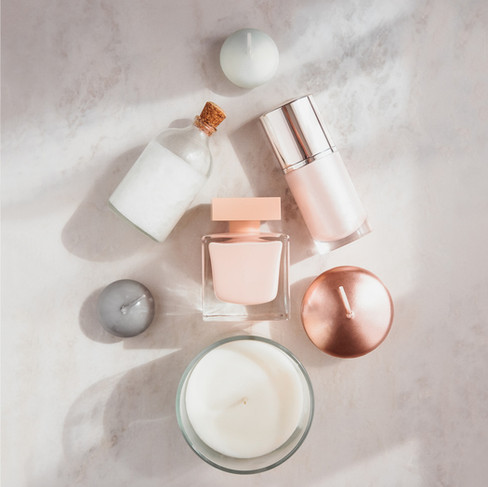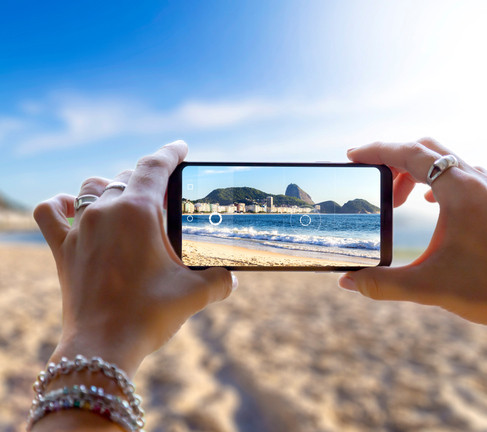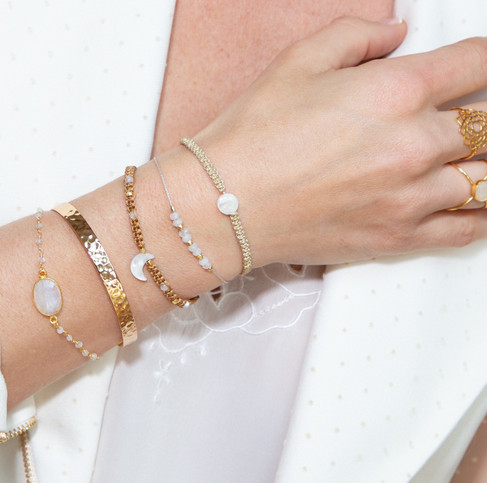How to Choose Photography to Represent Your Brand
- Kelli Erhardt
- Apr 23, 2024
- 7 min read
Selecting the right photography to represent your brand is important to make a strong first impression with your ideal customers and clients. They say a picture is worth a thousand words, and this is no different. The photos you choose communicate your brand's story, values, and the personality of your products or services to your audience.
Four Questions to Ask Yourself to Guide Your Photography Choices
Does this photo reflect my brand's values? Choose photos and imagery that are values aligned and also think about what that photo or image is communicating to your customers and clients. If you get a positive or negative emotional response when viewing a photo or image, it may be likely to trigger similar emotions in your clients and customers. If you are very concerned about a particular photo or image, phone a friend or trusted connection to reinforce your thoughts or challenge your expectations.
Is this photo representative of my target audience? When you are choosing photos, especially when it involves choosing photos with people in them, think about who is in your target audience demographic. If you have a product or service that you want Generation Z to purchase, you probably don't want to include photos of older individuals, unless it is intended to connect across multiple generations. If you think of how car commercials like those for Subaru show a diversity of races, ethnicities, and ages because they want to promote their cars to a variety of people, run that same thought process for your business.
Does this photo look authentic? When you are choosing photos for your brand, consider whether they authentically represent your brand. For example, since our founder is a woman of color, she often aims for photos that highlight her diverse background and lived experience – you may see photos and symbols indicative of her Hawaiian, Japanese and Filipino heritage, and images of other women and diverse communities that represent her clients, employees, and contractors who are a part of AshbeanPDX. You may also choose to avoid imagery that is overly staged and "fake."
What is the quality of the photo that I am using? While you may not want photos to look overly posed or "fake" as some stock photography may appear, you still want photos that are a high quality. Think about whether it is clear in the photo what is happening, or will it leave the viewer guessing? Choose photos that are complementary to your branding and brand colors, have well-lit subject matter, and communicate effectively to match your goals.
Examples of Brand Photography Styles
There are many different styles of photography you can leverage for your brand. Here are some of our favorites that can make your brand shine.
Still Life
Still life photos use a combination of props, backgrounds, and lighting to create compelling images that align with your brand's visual aesthetic and evoke emotion. Maintaining a consistent style across all your marketing channels reinforces brand identity and creates a cohesive visual experience for customers. The examples below showcase multiple products with a matching color scheme and also a single product highlighted on a pedestal.
Exciting Locations and Destinations
Photos in exciting locations and destinations can enhance your brand's personality. This type of photography may do well if your products are used for travel or just to highlight the worldliness of your brand. In the examples below we show a couple overlooking Machu Picchu in Peru and someone taking a photo of someone taking a photo on their smartphone.
Monochromatic
Monochromatic photos have all elements in a single color. Monochromatic images create a sleek, timeless look, ideal for brands aiming for sophistication. You can leverage your brand's colors to enhance your photos or even leverage black and white photos to set the mood. Remember that if you choose this route, you should maintain a consistent brand experience with your photos and not pop back and forth between styles.
Golden Hour
Golden hour, that magical time shortly after sunrise or before sunset, offers photographers a unique opportunity to capture stunning images with warm, soft light. During this time, the sun sits low on the horizon, casting long, diffused shadows and a golden hue across landscapes. The gentle, flattering light enhances colors, textures, and contrasts, adding depth and dimension to photographs. Whether shooting portraits, landscapes, or still life scenes, taking photos during golden hour can result in captivating images with a warm, inviting glow that can make your brand feel more welcoming and emotive.. In the examples below, golden hour is captured on Waikiki Beach in Honolulu, Hawaii enhancing the feeling of being in a tropical paradise and a family enjoying an early morning photo shoot in a park.
Pop of Color
Your photos can be enhanced with the addition of a single pop of color or by the lack of color. Using a pop of color in your brand photos can make it more memorable with your prospective customers. In the examples below, the subject matter stands out because they are standing in front of a yellow accent wall, and in the image on the right, the action of the man speaking into the megaphone is enhanced because the color is spilling out of it and he is in black and white.
Everyday Activities
Photos do not necessarily need to be posed or curated in any particular way, you may choose to feature photos of yourself or others doing everyday activities. Using this type of photography can humanize your brand, making it more relatable and approachable. In the examples below an older couple is shopping at a farmer's market and a young woman is walking her dog.
Lifestyle
Similar to the example above of everyday activities, your brand can also showcase lifestyle photos, meaning realistic photos of people living their lives. Lifestyle shots that depict your product in real-life situations or showcase your service in action can significantly enhance engagement with your brand. In the examples below we showcase a family watching their son learn to ride a bike and a group of friends enjoying conversation at a coffee shop.
Content Pour Out
To enhance your brand's product photography, a content pour out photo style intentionally shows your product being artistically spilled or displayed—adding an element of storytelling and may potentially invite viewers to imagine the experience of using your product. In the examples below, we show a bag of coffee beans poured out that shows the texture of the product and in the other example the nail polish dripping out of its container showcasing the product's color.
Packaging Details
Another way to enhance your product's brand is to show off its packaging design. You may want to choose this photo style if your packaging is unique or eco-friendly as that can appeal to viewers’ aesthetic preferences and values. In the examples below we show products that are consistently labeled with the same branded leaf motif and in the other a unique decorative box design with Japanese influences.
Hands in the Shot
You can choose whether or not you have hands in your product shot to give it a personal touch and make your products feel more tangible. In the examples below we show a hand pouring a product from a jar which can also give your viewer a sense of its consistency and in the other example a hand and arm wearing multiple bracelets and rings can give a customer a sense of their size and if they match well together.
Mirrors
Using mirrors can create intriguing reflections and depth in your photos. You can also use them to enhance your product images if you place them on a mirrored and reflective surface. Keep in mind what shows in the reflections though and that you don't accidentally put something in your photo that you don't want to show. In the examples below a mirror shows a separate area of a room and in the other example, we see a man trying on a pair of glasses.
Blurred Backgrounds
Photographs with blurred backgrounds focus attention on the subject and reduce distractions. In the examples below we see a man standing in an office with a blurred background and in the other example, a table filled with food at a backyard social gathering with people dancing in a blurred background.
Working from Home
Images depicting working from home or remote lifestyles will help you resonate with today’s workforce. This style of photography also reflects values of flexibility and can give a sense of modernity. In the examples below we show a woman seated in front of her couch working on her laptop with her Boston terrier laying behind her and in the other example, a father is working on his laptop at the dining room table with his young daughter coloring with crayons and wife and son in the kitchen serving as a backdrop.
Geometric Shapes
Incorporating geometric shapes can add a layer of sophistication and help organize content in your photos, making them more digestible and visually appealing. In the examples below you could insert your products on top of or in front of the geometric shapes to create a coordinated scene that shows off your products.
No matter which of these photo styles you choose for your brand, remember you should aim for consistency. Whether you are using the photos on your website, print materials, social media, or other digital marketing channels you want to ensure your brand can be recognized across all of these spaces. If you use too many competing styles, your customers may become confused and not associate the photos with your business.
Sourcing Stock Photography
While you may choose to take your own branded photos for your business you will likely need to backfill with some stock photography from time to time. We have compiled a list of recommended stock photography websites where you can source diverse and inclusive photos.
Free Stock Photography Websites
Below are our top recommendations for royalty free stock photography. Because many of the photographers and artists who are on these sites are trying to make a name for themselves, we recommend crediting them when you use their photos so that others know who the source is.
Nappy.co: High-quality images of Black and Brown people.
AffectTheVerb.com: Celebrating disabled BIPOC individuals.
GenderSpectrum: Lifestyle images of trans and non-binary models.
National Archives: Historical events images, most in the public domain.
Morgue File, Reshot.com, Unsplash, Pexels: General free stock photos, including diverse collections.
Paid Stock Photography Websites
DisabilityImages: Lifestyle images of people with disabilities.
Mocha Stock: Images of people of color.
POC Stock: Diverse images including Black, Asian, Hispanic, Indigenous, LGBTQIA+, and differently-abled people of color.
Tonl.co and Eye for Ebony: Culturally diverse and high-quality images of people of color.
iStock and Adobe Stock: Paid stock photo sites with continuously updated collections, the photos in the photo styles above were sourced from these websites.
Incorporating a variety of these photography styles and drawing from diverse photo resources can create a more inclusive, engaging, and visually appealing website. Remember, the images you choose are powerful tools to communicate your brand’s identity and values, so select them with intention and care.
Download Our Free Resource: Photography Guidelines Overview
Use this free download to answer important questions to formulate your brand's photography guidelines. Your ultimate goal in creating photography guidelines for your business is to ensure that the photography that you source is on brand and communicates effectively your brand promise to your customers.
























































